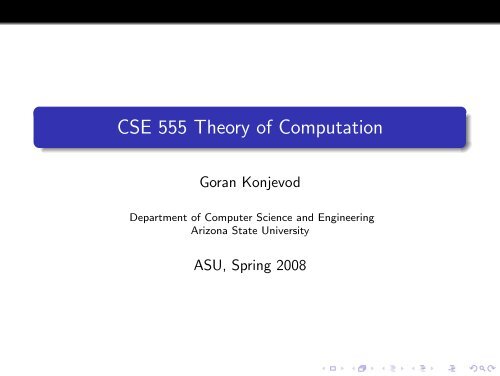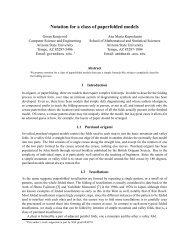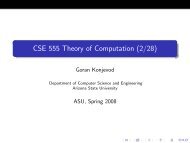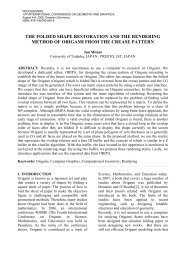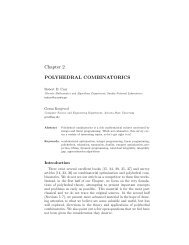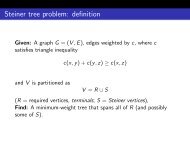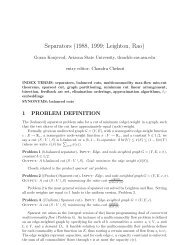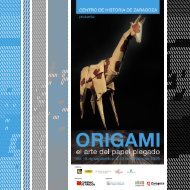CSE 555 Theory of Computation - Organic Origami
CSE 555 Theory of Computation - Organic Origami
CSE 555 Theory of Computation - Organic Origami
Create successful ePaper yourself
Turn your PDF publications into a flip-book with our unique Google optimized e-Paper software.
<strong>CSE</strong> <strong>555</strong> <strong>Theory</strong> <strong>of</strong> <strong>Computation</strong><br />
Goran Konjevod<br />
Department <strong>of</strong> Computer Science and Engineering<br />
Arizona State University<br />
ASU, Spring 2008
Logistics 1<br />
Instructor: Goran Konjevod, BY450, goran@asu.edu<br />
Office Hours: TTh 10:30–12:00<br />
TA: Wei Chen, BY415AA, wchen10@asu.edu<br />
Office Hours: M 12:30–2:00, W 4:30–6:00
Logistics 2: Evaluation<br />
Homeworks (7–9), 30%<br />
Midterm (weekend take home), 30%<br />
Final (Thu 5/1, 7:40–9:30AM), 40%<br />
Programming Assignment (3/6–4/29), 10%
Homework 1<br />
Due 1/22 at the beginning <strong>of</strong> class.
Homework 1<br />
Due 1/22 at the beginning <strong>of</strong> class, at 9:15AM.
Homework 1<br />
Due 1/22 at the beginning <strong>of</strong> class, at 9:15AM.<br />
Late homework will not be accepted.
Outline <strong>of</strong> Course<br />
1 Regular languages<br />
2 Context-free languages<br />
3 Turing machines and decidability<br />
4 Complexity theory
General Questions<br />
What is <strong>Computation</strong>?<br />
How to think about <strong>Computation</strong>?<br />
Better: How to model <strong>Computation</strong> mathematically?
<strong>Computation</strong>: basic properties<br />
Input →(process)→ Output.<br />
To describe a computation, must describe formally<br />
1 Input<br />
2 <strong>Computation</strong> process<br />
3 Output
Informal definition <strong>of</strong> computation<br />
<strong>Computation</strong> is a process that transforms strings into strings.<br />
(We won’t actually use this as a definition, but it could be done.)
Programs<br />
We’d like to describe computations independently <strong>of</strong> input/output.<br />
Program:<br />
Takes input<br />
Produces output<br />
Specifies computation as a finite sequence <strong>of</strong> steps to be<br />
applied to the input in order to produce the output. This<br />
specification does not depend on the input or output.<br />
Program describes many different computations.
Modeling computation by programs<br />
Arbitrary mappings between strings may be very complex.<br />
Take an infinite set Σ ∗ (say, all strings).<br />
The number <strong>of</strong> mappings from Σ ∗ to Σ ∗ is larger than the number<br />
<strong>of</strong> elements <strong>of</strong> Σ ∗ . (Diagonalization.)<br />
On the other hand, each program has finite length and so they can<br />
be listed in a sequence.<br />
Consequence: there are some computational problems that cannot<br />
be solved by a finite-length program. (Undecidability.)
Restrictions<br />
Study computation as performed by specific computational devices<br />
(machines).<br />
The processes studied at any moment include only those solvable<br />
by the machine.<br />
We’ll study three computation models in this course:<br />
1 Finite Automata<br />
2 Push-Down Automata<br />
3 Turing Machines
Finite Automata<br />
Input: a string over some given alphabet Σ.<br />
Output: Yes/No.<br />
Machine:<br />
1 Reads input one symbol at a time.<br />
2 At each moment, is in a unique state.<br />
3 Before reading any input, is in start state.<br />
4 If now is in state q and reads input letter a, there is a unique<br />
state δ(q, a) in which it will be the next moment.<br />
5 <strong>Computation</strong> halts when input is exhausted.<br />
6 If halted in an accepting state, output is Yes, otherwise<br />
output is No.
Finite Automaton Definition<br />
A finite automaton is a 5-tuple (Q, Σ, δ, q 0 , F ), where<br />
Q is a finite set (<strong>of</strong> states).<br />
Σ is a finite set (alphabet, its elements denoted as letters or<br />
symbols).<br />
δ is a function δ : Q × Sigma → Q (the transition function).<br />
q 0 is an element <strong>of</strong> Q (the start state).<br />
F is a subset <strong>of</strong> Q (the set <strong>of</strong> accepting states).
Finite Automata: once more<br />
Input: a string over some given alphabet Σ.<br />
Output: Yes/No.<br />
Machine:<br />
1 Reads input one symbol at a time.<br />
2 At each moment, is in a unique state.<br />
3 Before reading any input, is in start state.<br />
4 If now is in state q and reads input letter a, there is a unique<br />
state δ(q, a) in which it will be the next moment.<br />
5 <strong>Computation</strong> halts when input is exhausted.<br />
6 If halted in an accepting state, output is Yes, otherwise<br />
output is No.
Acceptance by FA<br />
A string u over Σ is accepted by a FA M, if after M reads u,<br />
starting from q 0 , M ends up in an accepting state.<br />
The set L(M) <strong>of</strong> all strings accepted by M is called the language<br />
<strong>of</strong> the machine M. (We also say that M accepts or recognizes<br />
L(M).)
Regular languages<br />
Let Σ be an alphabet.<br />
A set L <strong>of</strong> strings over Σ is regular, if there exists some FA M<br />
such that L = L(M).<br />
To study finite automata, it should be enough to study regular<br />
languages.
Some notation<br />
String with no letters: ɛ.<br />
If Σ is an alphabet, then Σ ∗ denotes the set <strong>of</strong> all strings over Σ.<br />
Examples: Σ = {0}, Σ = {0, 1}, Σ = ∅.<br />
A language is a set <strong>of</strong> strings: L ⊆ Σ ∗ .
Regular operations<br />
Let A, B ⊆ Σ ∗ .<br />
Union: A ∪ B = {x | x ∈ A or x ∈ B}.<br />
Concatenation: A ◦ B = {xy | x ∈ A and y ∈ B}.<br />
Star: A ∗ = {x 1 x 2 . . . x k | k ≥ 0 and each x i ∈ A}.<br />
Theorem: The class <strong>of</strong> regular languages is closed under the<br />
regular operations.


